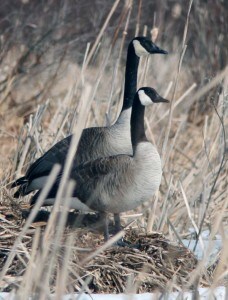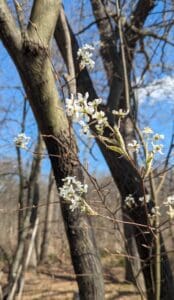
(Chelsea Update would like to thank Tom Hodgson and the Waterloo Natural History Association for the information and photos in this story.)
Like it or not, it appears that the giant Canada goose is here to stay.
Hunting, the sport for which the geese were introduced in the first place, has not been effective in controlling the population. Why has this been the case? First, the number of people choosing to hunt has been on the decline for many years. There are just not as many people out hunting geese and other game animals as there used to be. Even offering extended seasons has had minimal impact.
Second, the geese quickly respond to hunting pressure by relocating to urban parks, and to lakes that are completely surrounded by residential property where hunting is not allowed or would be difficult.
Third, hunting seasons occur after the nuisance season rather than before it. Late spring and summer is the time when geese cause the most problems. The goose harvest occurs too late in the year to reduce nuisance geese. Those individuals harvested by hunters in the fall and winter are more than replaced by new birds during the next nesting season.
Fourth, the Canada geese, those true symbols of the wild, are not so wild any more. They have become accustomed to people. Some among us have perpetuated this by feeding them. Most of us have enhanced our properties with lush green lawns, which it turns out provide perfect grazing areas for geese. It is even better if the lawns grow uninterrupted right down to the lake shores. Geese can waddle right up onto a lawn from the lake without fear of hidden predators.

Although few of us may be willing to give up our lawns, there is one landscaping adjustment that can be made to discourage grazing geese. A row or strip of tall ornamental grasses or shrubs planted along the lake shore can be a fairly effective deterrent because the geese see these as sites where potential predators might be hiding. This technique is most effective when adopted by the majority of lakeshore property owners.
The shorelines of many local lakes are so developed that they offer few places for geese to nest. Yet geese and their young appear like magic on these lakes every May. Why so? There are so many small wetlands scattered throughout the Chelsea area that there is no need for the geese to nest right on the most developed lakes. In most cases, it’s just a short waddle from these wetland nesting sites to the lakes themselves where the lush green, predator free lawns are total goose magnets.
Some residents have purchased dogs to patrol their lawns to chase the geese away. Dogs, of course, can leave their own deposits.
Others have purchased dog silhouettes that may accomplish the same end until the geese figure out that they are not real. Acetylene guns have also been employed to frighten the geese away, but they can also frighten the neighbors. They, too, lose their effectiveness after a while.
The DNR has initiated some other population control measures in problem areas including destroying nests in spring, or oiling the eggs so they do not hatch. Such methods, though sometimes effective, are labor intensive and are not always well received by residents.
Goose round-ups offer a short-term solution to nuisance geese. From late June through mid-July geese and other waterfowl species molt all their flight feathers and grow new ones. Until this process is completed they cannot fly and can easily be herded into pens and relocated.
Unfortunately, once they regain the ability to fly, many return. So, the only way to prevent the return flights is to euthanize the birds. Then the birds may be processed and the meat donated to soup kitchens and homeless shelters. Many people find this objectionable as well.
Private individuals who wish to have geese relocated must first get a permit from the DNR at the cost of $200 and they may also be responsible for the cost of the relocation. In the case of a local lake where there are many properties, a petition must be signed by 70 percent of the land owners before a permit can be issued.
Currently, the best solution may be to make the above mentioned landscaping adjustments on lake front property, refrain from feeding geese and enjoy them from a distance. Perhaps there is a lesson here to be learned by wildlife managers as well – plans developed with the best of intentions sometimes come with unintended consequences.















